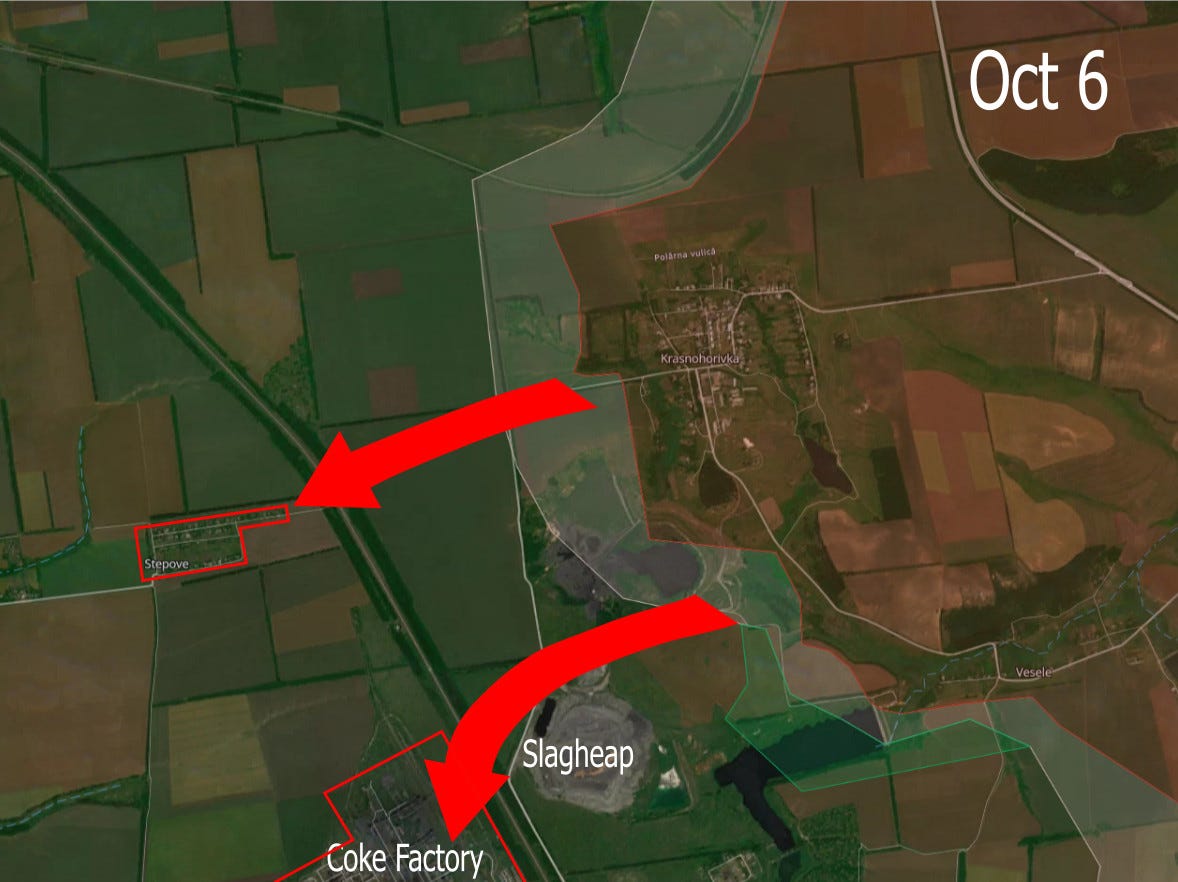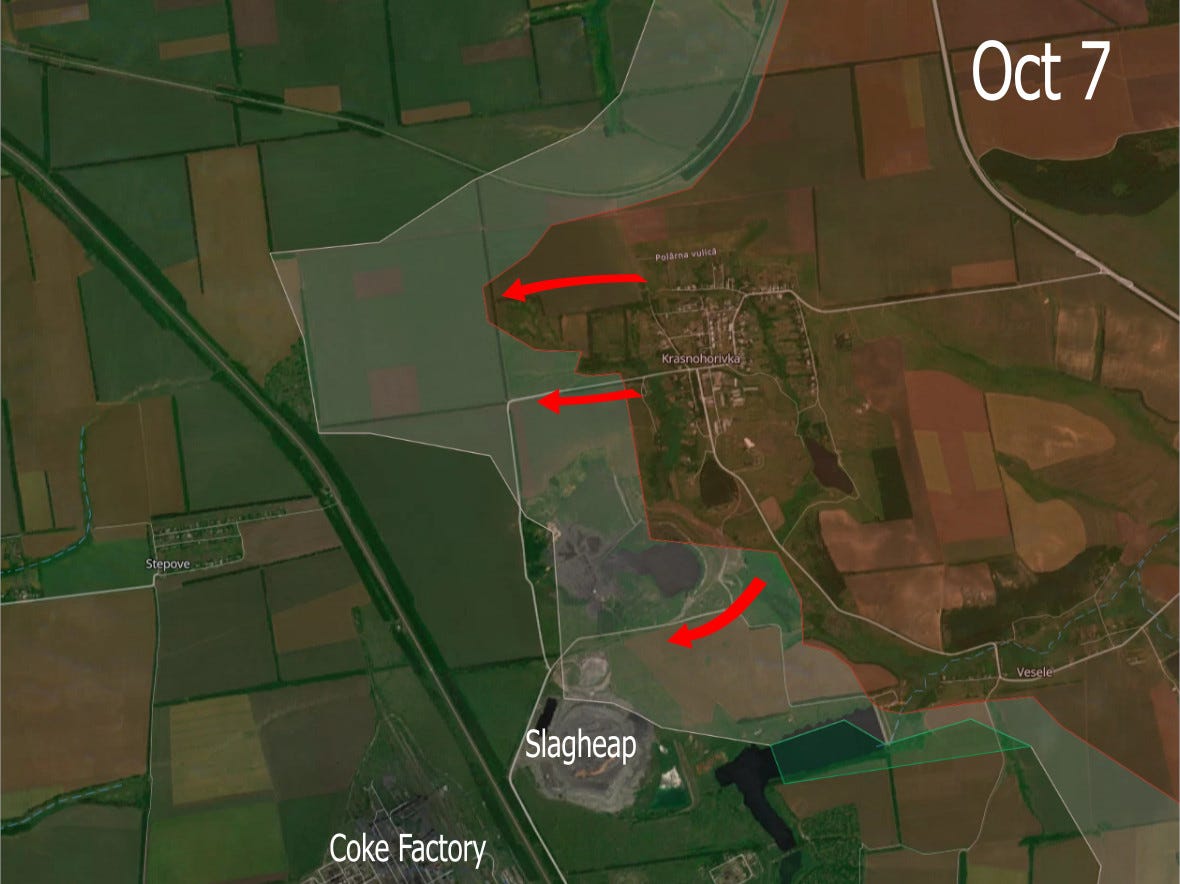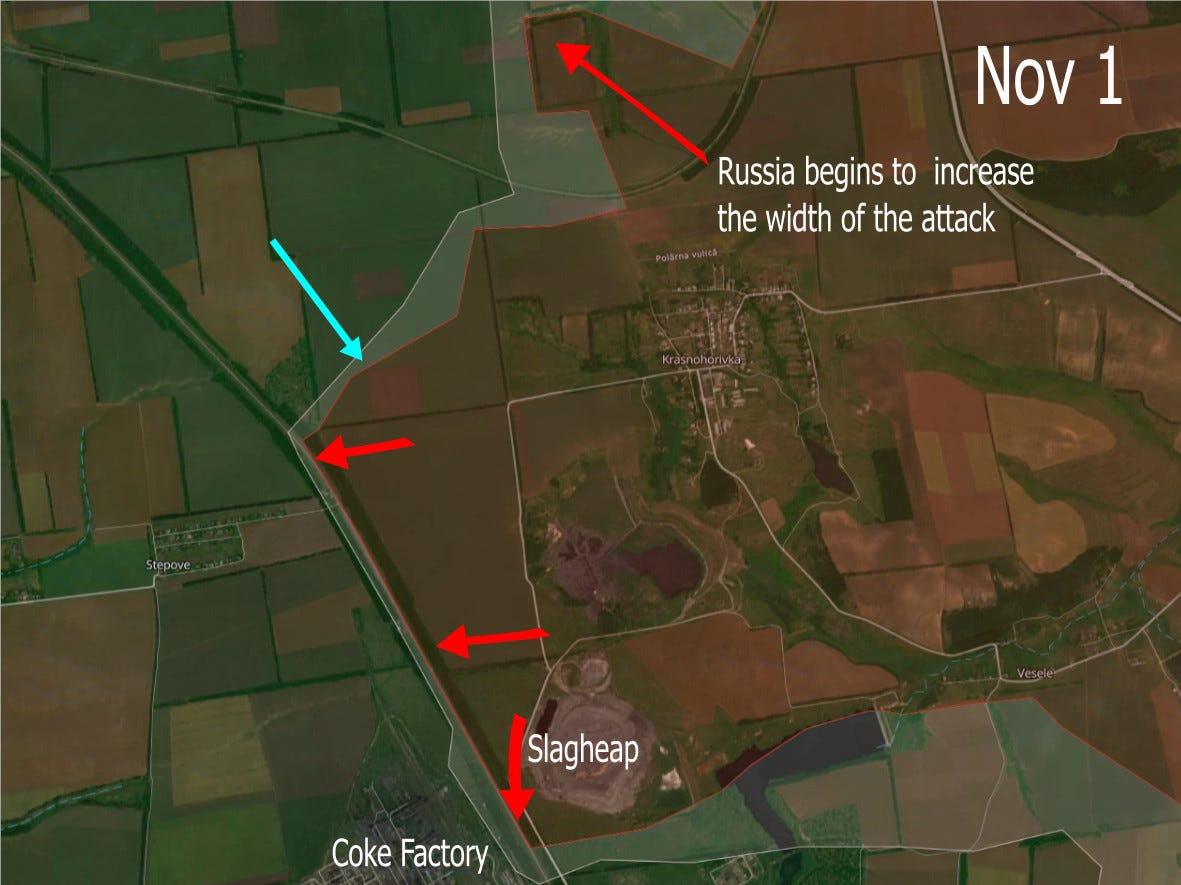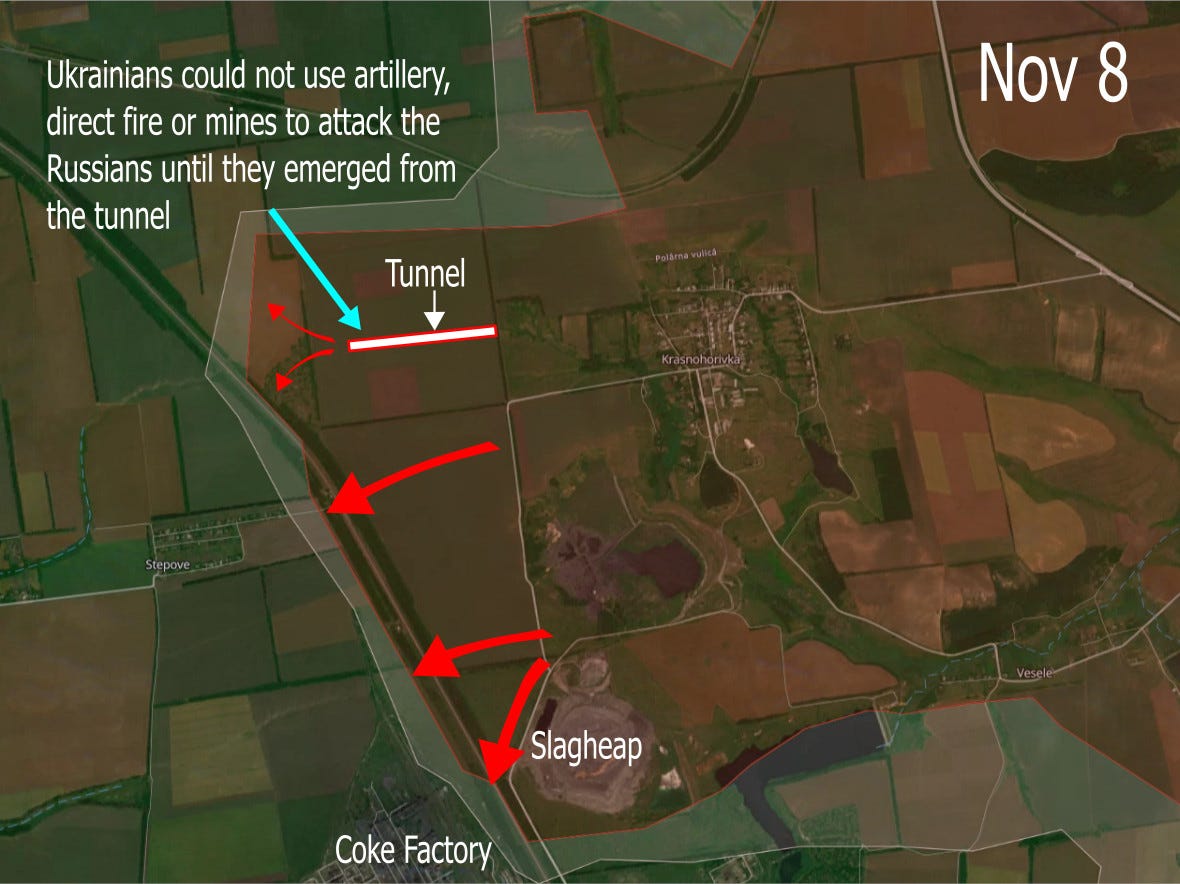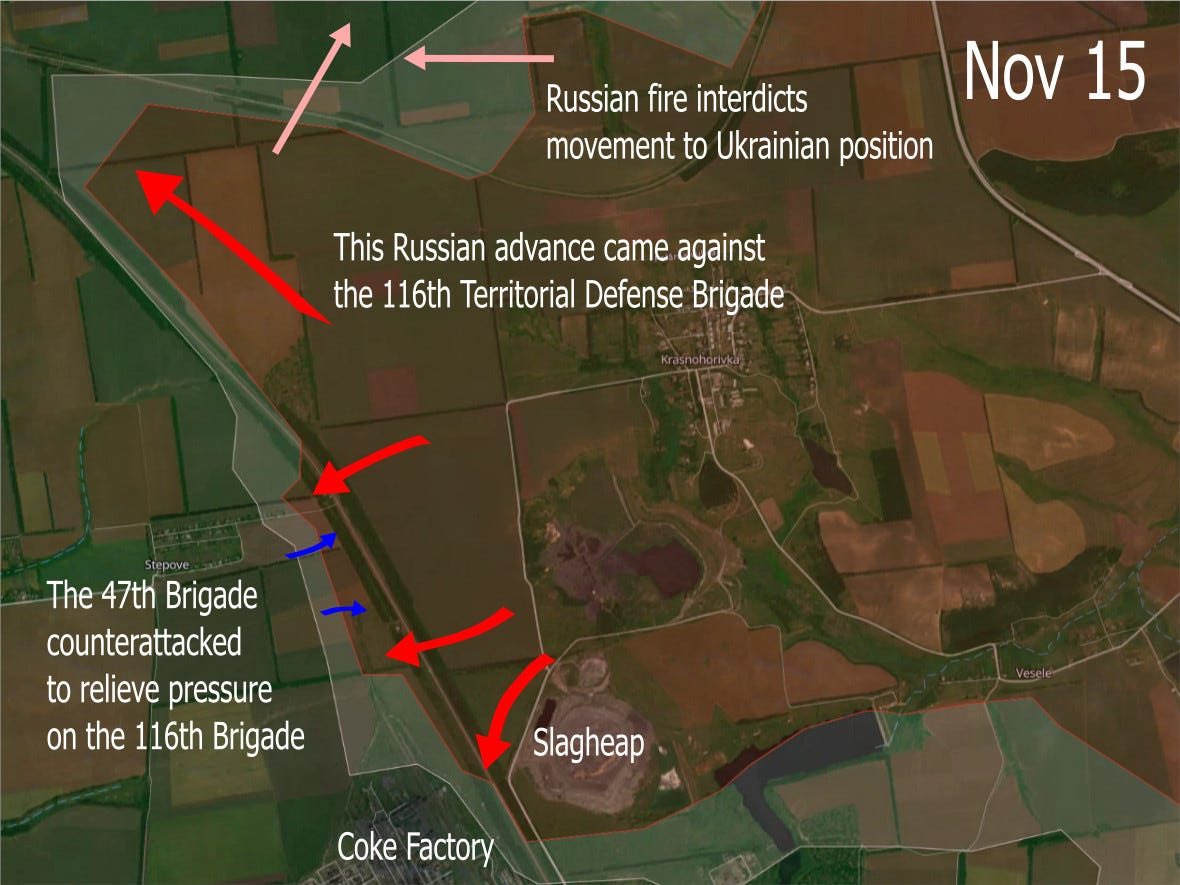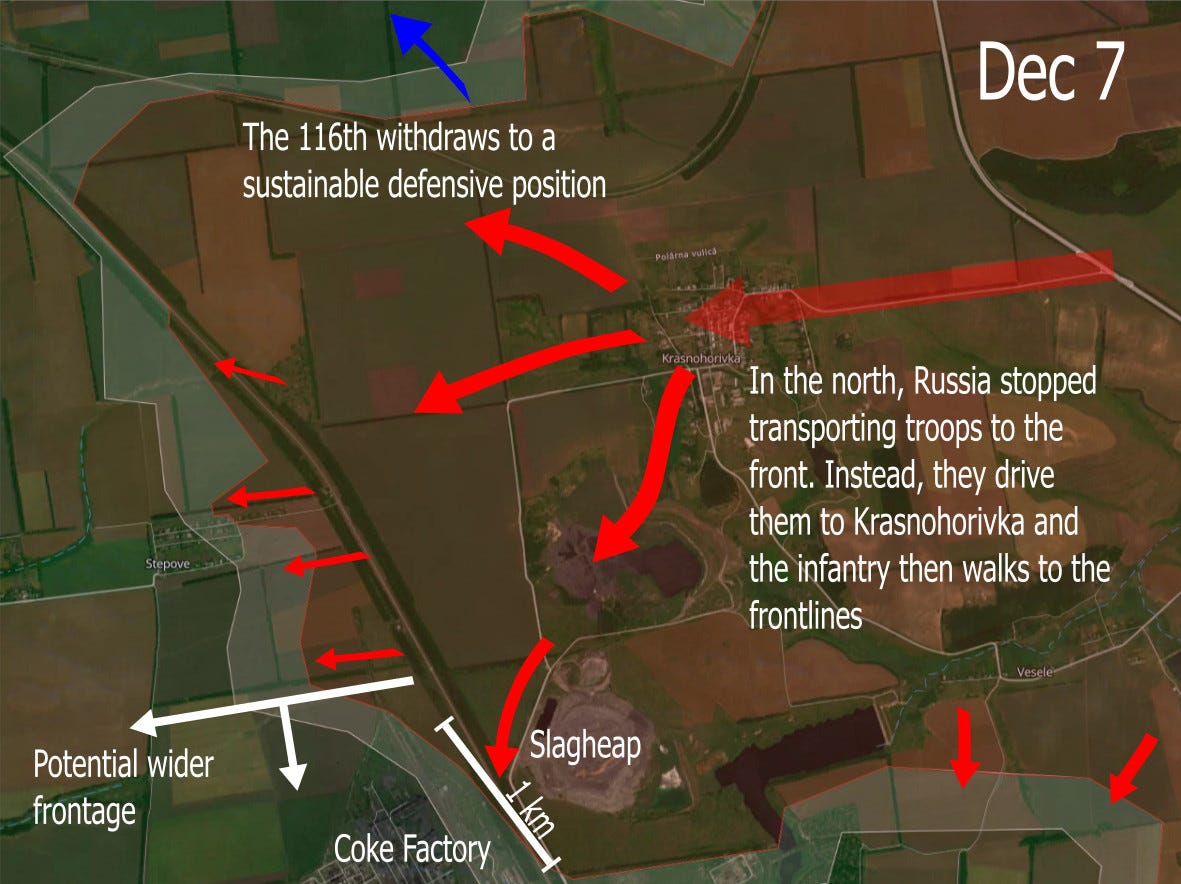Russia began their offensive focusing on the two flanks, hoping they would meet in the middle and encircle Avdiivka. Virtually no advances have been made in the south and progress was slow in the north, so they began a frontal push that managed to take the industrial park southeast of Avdiivka but that seems to have stalled, as well. The Russians are starting to put pressure on Ukrainian defenses three kilometers east of the coke factory and we’ll see what comes of that. But so far the only significant progress Russia has made has been the 2.5-3 km gains in the north. This is a look at how that happened.
Almost all of the videos have been shown before. They are being used again to illustrate a point.
Like many places along the front, the Avdiivka sector has been attacked since February, 2022, but for the four months prior to the October offensive the front was pretty stable. As the Ukrainian summer offensive efforts wound down, Russia was looking for an opportunity to conduct a major push. Russia wants the initiative because the side with the initiative dictates the action. When forced to defend because of a stronger enemy force, they will still look for opportunities to counterattack and disrupt the enemy. This is why they continuously attack at Kupiansk and Svatove. If they take territory, great. If not, it keeps Ukraine in a defensive posture, and all it does is cost Russia men and equipment. But Russia wants Avdiivka, much like they wanted Bakhmut.
Since Avdiivka was already in a deep pocket and surrounded on three sides, Russia hoped that a strong push on both flanks would either encircle the town or narrow the passage so much that it would be too costly to supply the city and the defenders in the pocket.
In order for the northern flank to do its part in cutting off Avdiivka, Russian forces would have to take both Stepove and the coke factory.
On the first day of the offensive, Russia was able to grab 300 meters of treeline when attacking across the first field. Russian artillery pounded that treeline and their tanks and APCs provided direct fire support while the infantry dismounted. And the Russians launched wave after wave of attacks that added to the Ukrainian casualties, forcing Ukraine to expend their ammo. But what really aided the Russians was a perpendicular woodline leading right into the Ukrainian defensive line which provided cover for advancing Russians. Even worse, that perpendicular woodline zigzagged 300 meters away, providing even more cover for the Russians.
The cost for the Russians was high, both in personnel and vehicles. In the first five days there was a minimum of 45 vehicles visually confirmed as kills. It’s hard to say how many more were destroyed that could not be confirmed. The ground northeast of the slagheap was full of destroyed Russian vehicles. But despite the losses, the Russian attacks kept coming. This soldier fought further south in Avidiivka but what he describes is a widespread experience…https://twitter.com/wartranslated/status/1715631066982105127
Over the next fifteen days Russia managed to capture the rest of that treeline. Various parts of the treeline had been seized by the Russians several times but Ukrainian counterattacks would always push them out and reoccupy the defensive lines. Artillery from both sides would hit the treeline prior to their assaults and at some point the trenches were no longer viable defensive positions. Without trenches, Ukrainian troops would be exposed to heavier casualties from artillery, even if they held the line. The cost was too high; they fell back to the double treelines on either side of the railroad. Russia didn’t mind paying a heavy price, so they took over the treeline and continued attacking towards the railroad without a pause. The amount of vehicles they lost was staggering…https://twitter.com/wartranslated/status/1714931914262425978
The Russians also started digging in, even while under artillery fire and drone attacks. This is similar to their tactics at Bakhmut, where the first wave would walk as far towards the Ukrainian lives as they could, then the survivors would halt and start digging in so the next wave would have protection. But the Russians not only started digging defensive positions, they also started to dig a tunnel across the field. Defensive tunnels were first noticed near Robotyne, allowing Russian troops to resupply and move troops while protected from Ukrainian observation and fire. At Avdiivka, they were used to safely move across the open field and emerge only when they were close to Ukraine’s defensive positions. This example of Russians being caught in an open field is what they wanted to avoid…https://twitter.com/PStyle0ne1/status/1713920673561674079?s=20
And both the Ukrainians and Russians started using small wheeled robots controlled by operators to bring supplies to exposed positions, and Ukraine has also evacuated a wounded soldier by a cargo drone…https://twitter.com/bayraktar_1love/status/1733447207964090700
https://www.thedefensepost.com/2023/10/25/ukraine-russia-tunnels-robotics/?expand_article=1
The Russians were also able to move to the base of the slagheap and they even sent infantry up the steep sides, although none of those assaults were successful. One Ukrainian estimated that the Russians lost 20-30% of their vehicles before reaching their forward line to launch an attack. This diagram of the first week of the offensive indicates some of that…https://twitter.com/OSINTua/status/1714604462159835285
They did start targeting the Ukrainian infantry on top of the slagheap with drones. Even with defensive positions, there was no place to hide.
And Russian advances west of Krasnohorivka and by the slagheap allowed them to conduct direct fire on the route Ukraine used to supply and bring replacements to their defenses southwest of Krasnohorivka. By now, the Ukrainian 47th Brigade was withdrawn from the Robotyne sector and placed in the line to defend Stepove and the coke factory.
Unable to supply and send reinforcements to their defenses southwest of Krasnohorivka, Ukraine withdrew to the railroad treeline the next day. With that withdrawal, Russia’s assaults towards the railroad were no longer being hit in the flanks and they were able to threaten the Ukrainian defenses there.
There was also just one road up to the heights of the slagheap and it could now be interdicted by Russian fire from the positions Ukraine used to possess.
One day after Ukraine was forced to withdraw from their positions southwest of Krasnohorivka the were forced to withdraw from the slagheap. The constant drone attacks on limited defensive positions and the interdiction of the road leading to the top of the slagheap made it too dangerous to occupy. Russia tried to occupy it but also suffered from drone attacks, plus all the defensive positions Ukraine dug were on the eastern side of the slagheap. The first two drone bombs show attacks on Russian positions on top of the slagheap…https://twitter.com/NOELreports/status/1725165741790355971
Russia was now engaging Ukraine over 2.5 km of the railroad treeline and their constant waves of attacks allowed them to gain control over the eastern woodline that parallels the railroad. Ukraine would launch counterattacks and drive them out and then another three or four waves of Russians would force the Ukrainians back, sometimes because they ran out of ammunition. Sometimes the two sides would fire at each other across the railroad just 50-70 meters apart from each other. If Ukraine received ammo and reinforcements in time then they would generally be able to hold. But in order to reach their fellow soldiers, Ukrainian vehicles and soldiers would have to cross open fields that were constantly attacked by Russian artillery and drones. If Russian drones were overhead, the artillery and mortar fire was incessant, and the drones were almost always overhead. The only way Ukrainian troops could live is in deep trenches, and even then survival was a matter of chance…https://twitter.com/FundPerun/status/1725121353307590958
Both Ukraine and Russia had drones on the air but Russia had a lot more of them. Some of them would observe Ukrainian defensive positions and spot for artillery. Others would attack Ukrainian vehicles both on the front lines and a few kilometers behind it. Tanks, APCs and trucks bringing supplies and evacuating the wounded were hit. Infantry in the trenches were attacked with artillery and mortars. Efforts to destroy the Russian drones were sometimes successful but each attempt usually resulted in more artillery attacks.
Russia kept attacking across the railroad for a week without making progress. Sometimes they would take a section of the western side of the railroad only to get pushed back. Sometimes Ukraine would kick Russia out of a section on the eastern side only to be pushed back. Control of the eastern side of the railroad also gave the Russians some protection for the constant flow of Russian troops traveling across the fields trying to reach the eastern side. Ukraine wasn’t able to fire on them with troops on the ground, although Ukrainian drones were still able to call indirect fire on the columns or groups of troops. Here’s a video of a Russian column getting hit with artillery. They stay in a column because of the mines. If the path is safe for the first vehicle then it is safe for all the vehicles following behind it. When artillery knocks out one vehicle those behind move around it off the path and run over a mine…
This is another video that shows not only the Russian casualties but the density of the mines. When a vehicles detonates a mine it creates a pathway. To fill that pathway both sides use artillery to deploy mines. Sometimes the soldiers or robot vehicles will replace the mines...https://twitter.com/GloOouD/status/1723603640869343250
Tanks and Infantry Fighting Vehicles are very effective at infantry support. A Bradley uses its 25mm cannon on the Russians in the treeline…https://twitter.com/John20230/status/1721482469269029134
But Russian and Ukrainian drones are everywhere. In two days, Ukraine lost three Bradleys and a Leopard to drones. Another Bradley was immobilized by a mine…https://twitter.com/squatsons/status/1721955788934242648
Because they were having difficulty making progress against the railroad, Russia began to increase the width of the attack by using wave assaults north of Krasnohorivka. A wider front would allow Russia to bring more pressure to bear on the Ukrainian defenses and their artillery and drone responses wouldn’t be as concentrated.
One of the things the Russians do very well, better than the Ukrainians, is dig. They start digging when they take new positions in order to hold them. Given enough time, they dig connecting trenches, called communication trenches, between the front lines and the rear areas to safely bring up supplies and replacements. Sometimes these communication trenches become tunnels. A Ukrainian soldier explains that those that dig live longer…https://twitter.com/SomeGumul/status/1726219807769457036
And at Avdiivka the Russians started digging tunnels under deadly fields that terminated under the Ukrainian positions. They set off explosives under those positions, a tactic that has been used in WW1 and the American civil war. After that, they sent troops down the tunnel until they reached the spot where the explosion had collapsed it, and they dug a hole to the surface. From there, intact Russian troops poured out of the whole and cleared out what was left of the Ukrainian positions. This is a video of Russians using that tactic in the industrial part at the southeast end of Avdiivka…
Along the rail line, constant pounding by Russian artillery on Ukrainian defenses caused some of them to collapse. Russian assaults would then force some Ukrainians to withdraw from their positions. Prior to counter attacking, Ukrainian artillery bombard the same positions now occupied by Russians and the trenches would degrade even further. There was at least one occasion where Ukrainians brought shovels to dig in and hold the position relatively safely, but the constant Russian waves didn’t give them enough time to dig in. Sometimes the waves were only 15 minutes apart, and Ukraine doesn’t want to accept the higher casualties rates without defenses so they withdraw to the defenses that are still intact.
The Russians fight in a simple, brutal way that wears down the Ukrainians over time. If Ukraine can sustain their forces with replacements and ammo and repair their defenses that are damaged then they will usually hold. If not, they withdraw. It worked at Bakhmut and it’s had some success at Avdiivka and all it costs Russia is thousands of men and hundreds of vehicles. That’s a price Russia is willing and able to pay.
At this point, Russia suffered over 10,000 casualties. Ukrainian casualties haven’t been posted but if they are in the 2-3,000 range, that’s a lot.
In the next week, Russia was able to continue broadening the frontage by a huge 1.5 km advance up the rail line. This sector was guarded by a territorial defense unit, the 116th Brigade, not the 47th Brigade. The advance was stopped with the help of a lot of artillery and the 116th was able to stabilize the line with new defenses on a treeline.
One factor that helped the 116th out was a large attack by the 47th Brigade that seized over 200 m of treeline along the railroad. Russia diverted their forces to retake that section of the treeline but the 47th’s attack achieved its purpose.
With the front widened and the rail line secured, Russia then focuses on advancing along the three treelines perpendicular to Stepove. It’s the same tactic: Push forward, get pushed back. Keep pushing forward until a reasonable defense is no longer possible. Then secure the position, accepting the casualties while doing so, and that becomes the new front line. Repeat the cycle.
Several times Russia was able to reach the last three houses on the east end of Stepove only to be pushed out. As they advanced up the three treelines, there’s less flanking fire from Ukrainians and the distance they had to advance over open fields was reduced. And every time Russia advances and gets pushed back, Ukrainian defenses are degraded.
Even if they can’t take and hold the railroad treeline, Ukraine will conduct infantry attacks and direct fire attacks by Bradleys to cause Russian casualties and disrupt future assaults…https://twitter.com/RALee85/status/1728197379973894276
Over the next three weeks, Ukraine’s 116th Brigade consolidated its position and Russia was able to secure another 1.5 km of the western treeline along the railroad. This is part of Russia’s effort to widen the front and the more they can advance westward from there, the less flanking fire the Stepove attack will receive from the north. Sometimes the flanking fire can be a few snipers from 500-1500 m away…https://twitter.com/NOELreports/status/1730525545274757172
Russia is also trying to widen the front by attacking south on the northern flank. This sector is 2-4 km east of the coke factory. So far, Ukraine is holding firm. This video is 2 km east of the coke factory…https://twitter.com/RALee85/status/1733252629843620021
The main Russian effort remains Stepove and the coke factory. In earlier efforts Russia was contained to the very east end Stepove before being repeatedly pushed out. Recently, they’ve been able to reach the middle of the village. The Ukrainians pushed them back but the Russians are now holding the eastern third of the village. The endless waves of Russians keep washing against the Ukrainian defenses and the blood of Russians is slowly eroding them away. Here is a video of the fighting in the village…https://twitter.com/wartranslated/status/1731618928504328267
The Russians have been attacking the coke factory on a narrow one kilometer front without any success. If Russian continues to advance along the Stepove axis it will create a wider front along the coke factory to its north.
One important change is that Ukraine brought in additional EW assets to combat the Russian air superiority in drones. It’s had an effect. Russian drone attacks have been reduced and Russian artillery has been impacted because there are few Russian drones to spot for them. That said, Russia is skilled in electronic warfare and they invested heavily in it. There’s no guarantee Ukraine will be able to maintain this advantage. Moves and countermoves are always available in the electronic battlespace.
Russia still has a long way to go before Andiivka is no longer tenable for Ukraine to hold. It will cost Russia a lot to keep advancing but they have 40,000 troops in the area, they’re mobilizing over 20,000 men a month. They have the initiative but Ukraine has shown they can launch a successful assault if they are willing to pay the price.
As an example, it was reported two soldiers from the 47th Brigade were shot as they surrendered…https://twitter.com/NOELreports/status/1730928387458289687
When they found out, the 47th organized an assault and they didn’t take any prisoners..https://twitter.com/666_mancer/status/1730288646568173600
In the meantime, the Ukrainians need to dig as if they were Russian.




